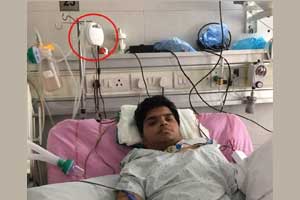- Home
- Editorial
- News
- Practice Guidelines
- Anesthesiology Guidelines
- Cancer Guidelines
- Cardiac Sciences Guidelines
- Critical Care Guidelines
- Dentistry Guidelines
- Dermatology Guidelines
- Diabetes and Endo Guidelines
- Diagnostics Guidelines
- ENT Guidelines
- Featured Practice Guidelines
- Gastroenterology Guidelines
- Geriatrics Guidelines
- Medicine Guidelines
- Nephrology Guidelines
- Neurosciences Guidelines
- Obs and Gynae Guidelines
- Ophthalmology Guidelines
- Orthopaedics Guidelines
- Paediatrics Guidelines
- Psychiatry Guidelines
- Pulmonology Guidelines
- Radiology Guidelines
- Surgery Guidelines
- Urology Guidelines
AIIMS team develops smallest ventilator costing only Rs 35,000!

Delhi, India: A young robotics engineer in Delhi, in collaboration with a neurosurgeon in All India Institute of Medical Sciences (AIIMS), have developed an advanced portable ventilator equipped with a tablet that costs ten to twenty times lower than those currently available in the market. This development has provided some hope and relief from hefty bills to people requiring ventilator support.
Cost of the advanced version of this portable ventilator, developed by robotics scientist Diwakar Vaish and Deepak Aggarwal, professor of neurosciences, AIIMS, starts from Rs 45,000. It has a fixed tablet displaying vitals such as pulse, blood pressure, etc. This will also help hospitals meet the shortage of beds. A large number of patients put on ventilators have to continue staying in hospitals as their families cannot afford the traditional life-saving machine for home.
According to the reports, AIIMS is the first hospital in the capital to successfully use it on patients.
"As per WHO India (2012) report, more than 2 million lives are lost every year due to lack of ventilators. This lack of ventilators is singularly because of the exorbitant costs- Rs 5 to 15 Lakhs for a ventilator- with additional requirements of trained manpower to operate the ventilator and infrastructure requirements like piped oxygen supply. It is for this reason that less than 9000 ventilators were sold in the whole of India in 2017, despite the requirement being in lakhs of units," Dr. Aggarwal told Medical Dialogues, speaking on the significance of this ventilator for India.
Also Read: International guidelines for hospital-acquired and ventilator-acquired pneumonia
The ventilator was developed for 20-year-old Sachin Sharma, suffering from cervical spine disease. He has been on ventilator support at the neurosurgery ward of the AIIMS for the last four years, and will possibly require it all his life. His family was unable to afford a ventilator that would have costed them around Rs 5-10 lakh.
“The home version of this ventilator will cost the family around Rs 35,000 as they don’t need a tablet and can connect it on their android phones. We are training the family on how to use the device… They are very excited to take him back home,” Dr. Aggarwal told Indian Express.
Designed in the shape of a bluetooth speaker, the ventilator is considered more patient-friendly and requires very little space, unlike the traditional life-support machine. It automatically detects breathing pattern and has a feature that alerts the attendant if there’s a problem.
"We have been able to design and build a completely indigenous ventilator (AgVA) with quality and features comparable to the best in the world at a fraction of the cost of their cost," Dr. Aggarwal further added, speaking to Medical Dialogues team. AgVa is one of the smallest ventilators ever built and can easily fit in ambulances, emergency rooms, wards & Intensive care units. It can be controlled through an android app and supports all the modes of ventilation, including Volume & pressure support ventilation.
"It also has built-in oxygen, etCO2 (capnography), pulse oximetry & ECG sensors so that there is tight integration of ventilation with patient parameters and separate monitoring equipment is not required. The base model (Agva home) costs Rs 35000 with top end version (AgVa Gold) costing only Rs 75000. AgVa has the potential to revolutionize the delivery of high-quality healthcare cost-effectively," said Dr. Aggarwal.
According to experts, the machine requires minimum electricity to run. “It is equivalent to 100 watts, which means using two tube lights. There is no need for a special technician to run these ventilators,” Professor Diwakar Vaish, said to Indian Express.

Disclaimer: This site is primarily intended for healthcare professionals. Any content/information on this website does not replace the advice of medical and/or health professionals and should not be construed as medical/diagnostic advice/endorsement or prescription. Use of this site is subject to our terms of use, privacy policy, advertisement policy. © 2020 Minerva Medical Treatment Pvt Ltd